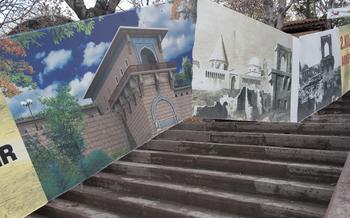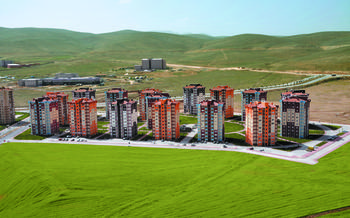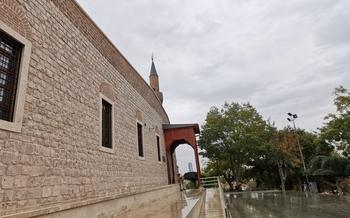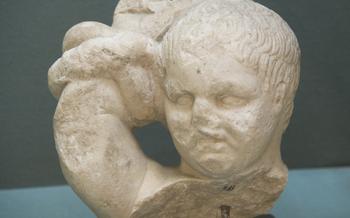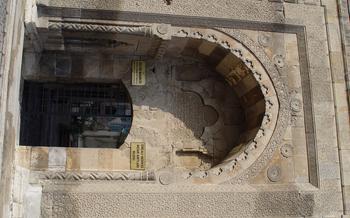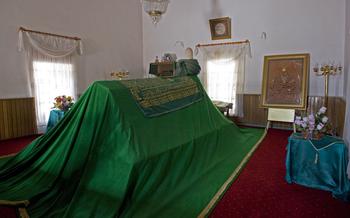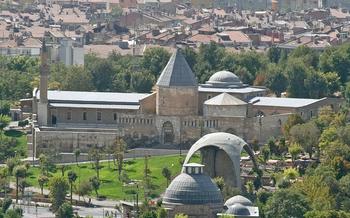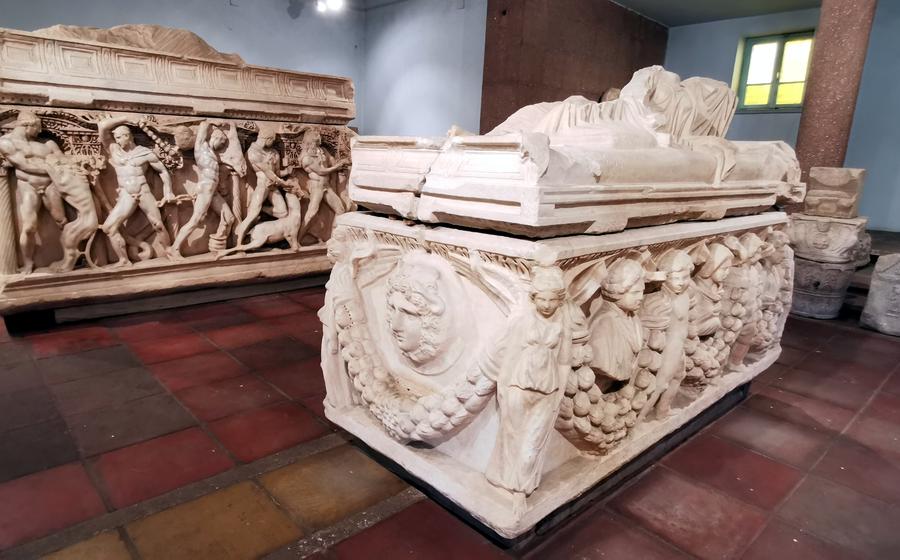
Konya Archaeological Museum
- Konya Archaeological Museum: A Treasure Trove of History
- Unveiling the Past: The Museum's Collections
- Exploring the Neolithic and Chalcolithic Periods
- Bronze Age Civilizations in Konya
- Hellenistic and Roman Legacies
- Byzantine Art and Christianity
- Islamic and Seljuk Masterpieces
- Interactive Displays and Educational Programs
- Planning Your Visit: Making the Most of Your Time
- Unveiling the Secrets of the Konya Plain
- Konya's Culinary Delights: A Taste of Anatolian Cuisine
- Shopping for Souvenirs and Local Handicrafts
- Cultural Events and Festivals in Konya
- Insider Tip: Secret Spots and Hidden Gems
Konya Archaeological Museum: A Treasure Trove of History
The Konya Archaeological Museum stands as a testament to the rich cultural heritage and diverse civilizations that have shaped the history of Konya. As one of the oldest and most significant museums in Turkey, it houses an impressive collection of artifacts, spanning from prehistoric times to the Islamic era. The museum's exhibits provide a glimpse into the lives, traditions, and artistic expressions of ancient communities that once thrived in this region.
From the Neolithic period, when the first human settlements emerged, to the rise and fall of powerful empires, the Konya Archaeological Museum offers a comprehensive journey through the ages. Must-see highlights include the Neolithic figurines, Bronze Age tools, and Hellenistic sculptures. Interactive displays and educational programs further enhance the museum experience, making it an ideal destination for history enthusiasts and culture seekers alike.
Unveiling the Past: The Museum's Collections
The Konya Archaeological Museum is home to a comprehensive collection of artifacts that span diverse historical periods and civilizations. These exhibits showcase the rich cultural heritage of Konya and provide insights into the development of human societies in the region.
The museum houses an extensive collection of Neolithic and Chalcolithic artifacts, including stone tools, pottery, and figurines, offering a glimpse into the early human settlements in the Konya region. These artifacts shed light on the transition from a hunter-gatherer lifestyle to agriculture, showcasing the ingenuity and adaptability of our ancestors.
The Bronze Age section features artifacts from the Hittite Empire, one of the most powerful civilizations of the ancient world. Bronze tools, weapons, and jewelry provide evidence of their advanced metalworking skills, while imported objects hint at their extensive trade networks and cultural exchange. Regional variations in artifacts highlight the diversity of Bronze Age cultures in Konya.
Hellenistic and Roman artifacts, such as sculptures, coins, and pottery, showcase the influence of Greek and Roman culture in the region. Mosaics and architectural fragments from Roman rule offer glimpses into the urban development and artistic traditions of Konya during this period. The museum also displays a fascinating collection of Byzantine icons, frescoes, and mosaics, which provide insights into the region's Christian communities and their interaction with Islamic culture.
Finally, the museum houses a remarkable collection of Islamic and Seljuk art and architecture. Ceramics, metalwork, and textiles from the Islamic period showcase the region's contributions to Islamic art and design. Seljuk architecture and decorative arts, including intricate carvings and tilework, reflect the dynasty's patronage of the arts and their role in shaping Anatolian culture.
Exploring the Neolithic and Chalcolithic Periods
Delving into the Konya Archaeological Museum's Neolithic and Chalcolithic exhibits is like stepping back in time to witness the dawn of human civilization. These collections transport you to an era when our ancestors first transitioned from nomadic hunter-gatherers to settled agricultural communities.
Among the captivating artifacts on display are an array of stone tools, crafted with precision and ingenuity. These simple yet effective implements, ranging from hand axes to scrapers, provide a glimpse into the daily tasks and subsistence strategies of our prehistoric predecessors.
Equally fascinating are the delicate pottery vessels, adorned with intricate patterns and designs. These ceramic creations showcase the artistic flair and technical prowess of Neolithic artisans, who transformed humble clay into objects of both beauty and utility.
Of particular note are the anthropomorphic figurines, imbued with symbolic and ritualistic significance. These small clay sculptures hint at the spiritual beliefs and cultural practices of these early societies, offering a tantalizing glimpse into their inner world.
Through these remarkable artifacts, the Konya Archaeological Museum unveils the story of human ingenuity, innovation, and adaptation during the Neolithic and Chalcolithic periods. It's a journey that invites us to marvel at the foundations upon which our modern world was built.
Bronze Age Civilizations in Konya
During the Bronze Age, Konya was home to several significant civilizations, including the Hittite Empire. The museum's collection boasts an array of artifacts from this era, providing insights into the region's rich history.
Bronze tools, weapons, and jewelry are among the many treasures on display. These artifacts showcase the advanced craftsmanship and technological prowess of the Bronze Age inhabitants. Visitors can also admire intricately carved seals and cylinder seals, which served as symbols of authority and power.
Evidence of trade and cultural exchange between Konya and other regions is also evident in the Bronze Age collection. Imported goods from Mesopotamia and the Aegean indicate the city's role as a crossroads of civilizations. Regional variations in pottery and other artifacts highlight the diverse cultural influences that shaped Konya during this period.
The Bronze Age exhibits offer a glimpse into the lives of the region's inhabitants, their beliefs, and their daily activities. Visitors can learn about the transition from nomadic lifestyles to settled agriculture, as well as the emergence of urban centers and the development of complex social structures.
Hellenistic and Roman Legacies
Konya's rich past extends to the Hellenistic and Roman periods, leaving an indelible mark on the city's cultural heritage. During the Hellenistic era, Konya fell under the influence of Greek culture, as evidenced by the exquisite sculptures, coins, and pottery unearthed from this period. These artifacts showcase the mastery of Greek artisans and the blending of Greek aesthetics with local traditions.
As the Roman Empire expanded, Konya became an important provincial center. The Romans left behind a legacy of mosaics and architectural fragments, which testify to their engineering prowess and artistic sensibilities. These remnants of Roman rule provide glimpses into the daily lives, religious practices, and architectural achievements of the Roman inhabitants of Konya.
The Hellenistic and Roman periods were characterized by extensive trade and commerce, leading to a vibrant exchange of ideas and cultural influences. Konya, situated at a strategic crossroads, served as a hub for merchants and travelers, facilitating the dissemination of goods, technologies, and cultural practices throughout the region.
Byzantine Art and Christianity
Konya's rich history extends to the Byzantine era, leaving behind a legacy of Christian art and architecture. Icons, frescoes, and mosaics from Byzantine churches adorn the museum's collection, offering glimpses into the religious and cultural life of the period.
These exquisite artworks depict biblical scenes, saints, and angels, showcasing the Byzantine Empire's renowned artistic style. Visitors can marvel at the intricate details, vibrant colors, and expressive faces that characterize Byzantine art.
The museum also houses architectural fragments from Byzantine churches, providing insights into the region's Christian heritage. These remnants include capitals, columns, and decorative elements that once graced the interiors of sacred spaces.
The interaction between Christianity and Islam during the Byzantine period is a fascinating aspect of Konya's history. The museum's collection includes artifacts that demonstrate the coexistence and exchange between the two faiths. This includes evidence of Christian communities continuing to thrive under Islamic rule, as well as the influence of Byzantine art and architecture on Islamic design.
Exploring the Byzantine section of the Konya Archaeological Museum is a journey through time, allowing visitors to delve into the rich artistic and religious traditions of this significant era.
Islamic and Seljuk Masterpieces
Konya's Islamic and Seljuk collections offer a glimpse into the city's rich cultural and artistic heritage. During the Islamic period, Konya flourished as a center of learning and culture, producing exquisite ceramics, metalwork, and textiles. The museum houses a remarkable collection of these artifacts, showcasing the intricate craftsmanship and artistic traditions of the era.
One of the highlights of the collection is the Seljuk architecture and decorative arts. The Seljuks, a Turkish dynasty that ruled Anatolia from the 11th to the 13th century, left an indelible mark on Konya's cityscape with their magnificent mosques, madrasahs, and caravanserais. The museum displays intricate tilework, carved stone, and calligraphy from these architectural wonders, offering insights into the aesthetic sensibilities and architectural prowess of the Seljuks.
The museum's collection also features a variety of ceramics, metalwork, and textiles from the Islamic period. Visitors can admire the delicate patterns and vibrant colors of glazed pottery, the intricate designs of metalwork objects, and the fine craftsmanship of textiles, all of which reflect the artistic and cultural influences of the Islamic world.
Konya's Islamic and Seljuk collections provide a fascinating glimpse into the city's rich cultural and artistic heritage. Whether you're an art enthusiast, a history buff, or simply curious about Islamic culture, this section of the museum offers a unique and immersive experience.
Interactive Displays and Educational Programs
The Konya Archaeological Museum offers a range of interactive displays and educational programs to enhance the visitor experience and make history come alive. Multimedia presentations and touchscreens provide in-depth information on the artifacts and the history of Konya. Workshops, lectures, and guided tours conducted by knowledgeable experts offer insights into the region's rich past. Interactive exhibits designed for children and families make learning about archaeology fun and engaging, while educational programs cater to students and researchers, providing opportunities for deeper exploration and understanding.
Planning Your Visit: Making the Most of Your Time
To make the most of your visit to the Konya Archaeological Museum, plan to spend at least two to three hours exploring its vast collection. Begin by familiarizing yourself with the museum's layout using a map or guide to identify the sections you are most interested in. Allocate more time for the exhibits that align with your interests, such as the Neolithic and Chalcolithic displays or the Islamic and Seljuk art collection.
Combine your museum visit with other attractions in Konya to create a comprehensive cultural experience. The Mevlana Museum, dedicated to the renowned Sufi poet Rumi, is a must-visit for those interested in Turkish history and spirituality. Take a stroll through the historic city center to admire the stunning architecture, visit the Sille ruins, or explore the vibrant local markets.
Personalize your itinerary based on your interests. If you are fascinated by ancient civilizations, prioritize the Neolithic, Chalcolithic, and Bronze Age exhibits. If Islamic art and architecture captivate you, focus on the Islamic and Seljuk sections. For a well-rounded experience, combine different periods and themes to gain a comprehensive understanding of Konya's rich history.
Capture your memories by taking photos of the museum's highlights. Ensure your camera is fully charged and that you have enough storage space. Respect the museum's photography guidelines, and avoid using flash or tripods in sensitive areas. Consider joining a guided tour to learn more about the artifacts and their significance. Guided tours are typically offered in various languages and provide an in-depth understanding of the museum's collection.
Unveiling the Secrets of the Konya Plain
Beyond the Konya Archaeological Museum, the city and its surrounding region offer a wealth of archaeological wonders that provide further insights into the rich history of Anatolia. One of the most remarkable sites is Çatalhöyük, located about 45 kilometers southeast of Konya. This ancient settlement, dating back to the Neolithic period (7500-5700 BCE), is considered the world's oldest known city. Excavations at Çatalhöyük have revealed a fascinating glimpse into the lives of its inhabitants, with well-preserved houses, communal spaces, and intricate wall paintings.
Another must-visit destination is Sille, an ancient Greek city situated just 10 kilometers west of Konya. Sille boasts an array of well-preserved ruins, including a Roman theater, a Byzantine basilica, and a Seljuk caravanserai. The city's narrow cobblestone streets, traditional stone houses, and charming cafes create a unique atmosphere that transports visitors back in time.
For those interested in Islamic history and culture, the Mevlana Museum is a must-visit attraction in Konya. This museum is dedicated to the life and teachings of Rumi, the renowned Sufi poet and mystic who lived in Konya during the 13th century. The museum houses a collection of Rumi's manuscripts, personal belongings, and artifacts related to the Mevlevi Order, the Sufi order he founded. Visitors can learn about Rumi's philosophy, poetry, and contributions to Islamic thought and spirituality.
Konya's Culinary Delights: A Taste of Anatolian Cuisine
A visit to Konya is not complete without savoring the delectable flavors of Anatolian cuisine. The city offers a diverse culinary scene, from traditional dishes passed down through generations to innovative creations inspired by modern gastronomy. Whether you prefer street food or fine dining, there's something to satisfy every palate.
Don't miss the opportunity to try Konya's signature dish, etli ekmek, a flatbread topped with succulent minced meat and vegetables, baked in a traditional stone oven. For a taste of local flavors, head to the city's bustling markets, where you can find a variety of street food, including gözleme (filled flatbread), börek (pastry filled with cheese, meat, or vegetables), and keşkek (a hearty dish made from wheat, meat, and yogurt).
For a more refined dining experience, Konya offers a range of restaurants serving traditional and modern Turkish cuisine. Be sure to sample dishes such as tirit (shredded meat served with a tomato-based sauce and yogurt), höşmerim (a sweet dessert made from shredded phyllo dough and milk), and künefe (a cheese pastry topped with syrup).
Vegetarians will find plenty of options, including vegetable kebabs, stuffed grape leaves, and a variety of meze (small plates) such as hummus, baba ghanoush, and ezme (a spicy dip made from tomatoes, peppers, and walnuts).
To truly immerse yourself in the local culture, consider taking a cooking class or attending a culinary workshop. Learn to prepare traditional Turkish dishes and discover the secrets of Anatolian cuisine. For those with dietary restrictions, many restaurants can accommodate special requests.
So, whether you're a foodie or simply looking for a taste of authentic Turkish cuisine, Konya offers a culinary adventure that will leave you wanting more.
Shopping for Souvenirs and Local Handicrafts
Konya offers a delightful array of souvenirs and local handicrafts that capture the essence of Anatolian culture. Inspired by the museum's collections, visitors can find unique mementos that reflect the city's rich history and heritage.
Traditional Turkish handicrafts, such as carpets, pottery, and jewelry, are popular choices for souvenirs. These exquisitely crafted items showcase the skills and artistry of local artisans.
To immerse yourself in the authentic shopping experience, visit local markets and bazaars. Here, you can browse through a variety of stalls selling carpets, kilims, ceramics, copperware, and handmade jewelry. Bargaining is a common practice, so don't hesitate to negotiate for the best price.
For those seeking a more curated shopping experience, Konya has several souvenir shops and boutiques that offer a range of high-quality handicrafts. These shops often collaborate with local artisans to create unique pieces that celebrate Anatolian culture.
Remember to pack your purchases carefully, as these delicate items may require special care during your travels. Whether you choose a hand-woven carpet, a ceramic bowl adorned with intricate patterns, or a piece of filigree jewelry, your souvenir from Konya will serve as a lasting reminder of your journey through history and culture.
Cultural Events and Festivals in Konya
Konya comes alive during its vibrant cultural events and festivals, offering visitors a chance to immerse themselves in the city's rich traditions and heritage.
-
The Mevlana Festival, held in December, is a grand celebration honoring the life and teachings of Rumi, the renowned Sufi poet and mystic. The festival features whirling dervishes, Sufi music, poetry readings, and exhibitions, creating a mystical and enchanting atmosphere.
-
The International Music Festival showcases a diverse range of musical genres from around the world. Held in June, the festival brings together talented musicians, performers, and music enthusiasts for a week of concerts, workshops, and cultural exchanges.
-
The Konya Rose Festival, held in May, celebrates the city's famous roses, which are renowned for their fragrance and beauty. The festival features rose exhibitions, rose-themed workshops, and a colorful parade, attracting visitors from near and far.
Attending these events is a fantastic way to experience Konya's vibrant culture firsthand. Remember to check the festival dates in advance and plan your visit accordingly to make the most of these unique celebrations.
Insider Tip: Secret Spots and Hidden Gems
Beyond the well-known attractions, Konya holds secret spots and hidden gems waiting to be discovered. Within the museum itself, visitors can explore lesser-known exhibits, such as the collection of ancient musical instruments or the display of traditional Anatolian costumes. Just outside the city, history buffs can delve into the fascinating past at underrated archaeological sites like the Karahöyük Mound, revealing ancient settlements dating back to the Bronze Age.
To truly immerse oneself in local life, venture into Konya's vibrant neighborhoods, where hidden cafes and traditional eateries serve authentic Anatolian cuisine. Engage with friendly locals at the weekly farmers' market, where fresh produce, handmade crafts, and local delicacies abound. For a unique perspective, join a guided walking tour led by Konya's passionate storytellers, who will unveil the city's hidden gems and share captivating tales of its rich history and culture.

